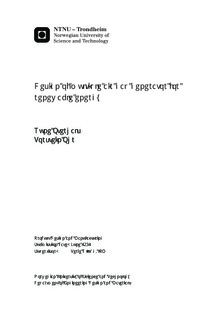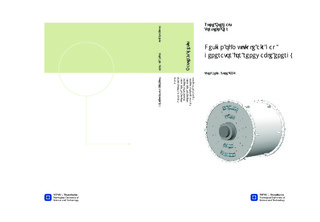| dc.description.abstract | The purpose of this project was to design and analyze the carrying structure of a multiple air gap generator for tidal turbine application. An initial patent pending electromagnetic design was provided by SmartMotor AS. Electromagnetic values, such as forces from the rotor-stator interaction, were given by SmartMotor. The final product is a 3D-model of the generator with dimensions and shape based on required power output, production and assembly limitations and static and eigenmode simulations.
The multiple air gap principle allows for a more compact generator, as there are several layers - in the radial direction - of rotors (magnets) and stators (windings) instead of one set of rotor and stator. A generator normally uses a gearbox to increase power output. This however increases maintenance and introduces more friction losses. By using multiple air gaps, the generator can potentially maintain the same size and power output while eliminating the gearbox.
The multiple air gap principle, as well as some basic electromagnetic theory, was discussed to give an insight in the planned generator. A requirement specification was set, with the most important ones being a power output of 1.1 MW and a maximum outer diameter of 3m. The rotor has 132 magnets in each layer and the stator 144 teeth, creating a varying force between the rotor and the stator. The air gap in each layer is initially 5mm, and the forces increase if the air gap gets smaller.
To evaluate different solutions for the carrying structure, the generator was broken down into smaller parts. Several design ideas were evaluated and discussed with engineers at SmartMotor. The chosen design was influenced especially by deformation and production/cost demands. Complex shapes become expensive and difficult to produce when the total diameter is above two meters. Instead it is used torque plates to counteract the torque forces and radial plates to counteract the bending from the radial forces. The most challenging parts to produce are the rings, which both the stator and rotor active parts are mounted to. These have to be casted due to its large size.
The chosen design was modeled and analyzed for deformations and stresses in UGS NX 7.5. To reduce simulation time and the complexity of the model, the stator, rotor and rings were simulated separately. Some simplifications and assumptions had to be done, but always on the conservative side. The results from the static simulations showed that increasing the axial length and decreasing the diameter resulted in a stiffer structure. The rotor and stator structure were also analyzed for eigenfrequencies in UGS NX, and it was these simulations which set the final dimensions for the generator structure.
The final generator has an outer diameter of 2.32m, a total length of 2.035m (excluding bearings) and uses 4 air gap layers. The total weight was estimated to 25.4 tons. A step-by-step description of the generator assembly was presented. Finally possible sources of error in the simulations and further work on the generator were discussed. | |

